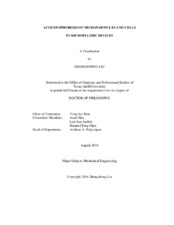| dc.description.abstract | Microfluidic acoustophoresis is a nonlinear acoustic phenomenon that can induce the motion of microparticles or cells under acoustic excitations in microfluidic devices. Existing acoustophoresis models, which are derived for “static” fluid media with “uniform” temperature distributions, have been mainly used for the design of acoustophoretic microfluidic devices. Therefore, it has been challenging to consider the effects of “moving” fluid media and spatial fluid medium temperature variation that significantly affect the acoustophoretic motion in a real microfluidic device. Here, it is proposed to develop a numerical modeling method that includes the effects of the moving fluid media and the temperature variation. Through the modeling analyses using the proposed numerical method, it was shown that the fluid medium flow and the temperature variation affected the acoustophoretic forces and the acoustic streaming significantly.
Around the cells or miroparticles, the acoustophoretic forces and acoustic streaming velocities induced by an ultrasonic excitation are of great interest in an extensive range of biomedical and mechanical applications. However, conventional methods to calculate the acoustic streaming require expensive computational costs and are inaccurate in the far field of the cells or microparticles. A new analytical algorithm is proposed to significantly improve computational efficiency as well as computational accuracy in the far field. The proposed algorithm is validated by comparing the results of the proposed method against those of a traditional method.
Based on the developed numerical and analytical modelling approaches, the following three applications have been investigated in this thesis.
1) The frequency responses of the acoustophoretic forces and acoustic streaming around the cells or microparticles were calculated and then the resonance frequencies were identified at the local maxima of the acoustic streaming velocities.
2) The trajectories of the cells or microparticles were analyzed by using the proposed modelling approach. By fitting experimental trajectories into the predicted one, the mechanical properties of the cells could be identified.
3) Based on the proposed modeling approach, a novel separation device design was proposed to separate the cells or microparticles depending on their subtle compressibility differences. The device consists of two stages where cells/microparticles are first aligned in the center of the microchannel and then separated depending on their subtle compressibility differences. | en |


